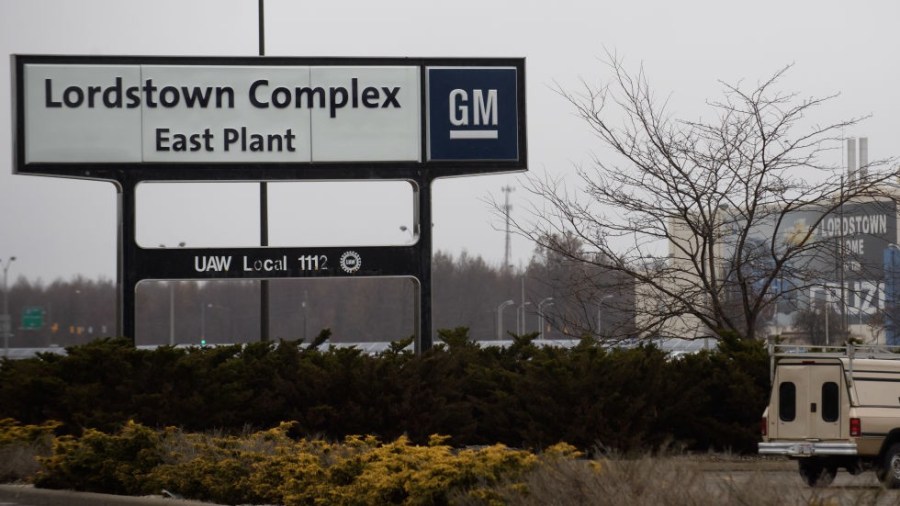The final Chevrolet Cruze sedan rolled down the assembly line at General Motors’ Lordstown, Ohio, plant on Wednesday, putting 1,500 workers out of work or looking for transfers and leaving local officials scrambling for ways to re-open the plant.
Located midway between Cleveland, Ohio and Pittsburgh, Pa., the plant is the first of five GM assembly operations in North America scheduled to end production by the end of 2020.
{mosads}Once employing some 3,000 workers, the Lordstown plant had experienced constant production cutbacks and employee layoffs in recent years due to slumping sales as consumers opted for sport-utility vehicles instead of traditional cars like the Chevrolet Cruze.
Workers are understandably sad and angry. They argue the workers and taxpayers stood by GM through its 2009 bankruptcy. They insist GM vehicles made in Mexico, like the recently introduced Chevrolet Blazer, should have gone to their plant.
The UAW that represents Lordstown workers has filed a federal lawsuit against GM, accusing the automaker of breaking its promise to them by breaching a labor contract.
Ohio’s two U.S. senators also expressed dismay at GM’s decision, which leaves the state without a GM assembly plant for the first time in nearly 100 years. Both suggested options, neither of which seem likely solutions.
Sen. Rob Portman (R-Ohio) said he will keep pressing GM to find a new product for the plant to build, possibly an electric vehicle: “GM says it will produce 20 new electric vehicles by 2023 and, at the very least, one of those should be in Lordstown,” Portman told the media, adding that not all GM EVs should be built in China.
An electric vehicle for Lordstown is no panacea. The best job security for workers at auto assembly plants is to build compelling vehicles that consumers really want to buy and that generate decent profits for the manufacturer.
Electric vehicles are neither. Electric vehicles in the U.S. are less popular and even less profitable than was the Chevrolet Cruze.
Electric vehicle sales have grown significantly from a non-existent base, but currently still represent only a couple percent of all new vehicles sold. Last year, U.S. electric vehicle sales from all automakers totaled roughly 360,000 units, with the largest portion by far being Teslas.
GM now builds the electric Bolt alongside the small Sonic sedan at an assembly plant outside of Detroit. It is running on only one shift, whereas GM’s truck plants are running on three shifts with weekend overtime.
The Michigan plant is the sole source for the Bolt EV, which is sold in the U.S. and exported. Bolt sales in the U.S. totaled 18,091 vehicles last year, down 23 percent from 2017, the first year the EV sold nationwide. By comparison, GM sold 142,617 Chevy Cruze models, also down 23 percent.
EV sales surely will increase as other automakers introduce their offerings to the market, but the segment will become increasingly competitive with a couple dozen new or redesigned entries hitting the market in the next few years.
Offering electric vehicles at lower price points, improving the range an EV goes on a charge and having adequate charging infrastructure are critical to mass adoption.
So are profits for manufacturers. No manufacturer is making money on EVs yet. Instead, they are pumping millions into developing them with no clear path to profitability anytime soon.
Indeed, GM has pledged to introduce 20 electric vehicles by 2023. Some will be built in China because China requires automakers to sell EVs to help reduce air pollution. Similarly, Europe is insisting on more EVs to replace diesels, though GM no longer sells vehicles in Europe.
Even with China and Europe demanding EV sales, most experts predict EV sales will only be 5-10 percent of total global sales in the 2025 to 2030 timeframe. And every manufacturer in the world, including a host of Chinese automakers, will be in the game. Not every company will win.
In the U.S., policies provide little support for growing EV sales. The federal government allows a $7,500 tax credit on an EV purchase but only until an automaker reaches 200,000 EV sales. GM and Tesla have hit that milestone.
Further, by April 1, the new Corporate Average Fuel Economy (CAFE) standards are to be announced. It appears as if the Trump administration will rollback standards from those put in place by the Obama administration.
Meantime, California, where the bulk of EVs is sold, intends to move forward with the stricter standards, which would require the sale of more EVs.
{mossecondads}The administration broke off negotiations with California regulators, who said they never really happened and that no progress was made to create one national standard, as automakers want. The two parties likely will be battling it out in courtrooms for years.
In terms of policy, Ohio’s other senator, Sen. Sherrod Brown, (D-Ohio), on the Lordstown’s plant last day, reintroduced his American Cars, American Jobs Act.
Among other sticks and carrots to encourage automakers to build vehicles in the U.S., the act would provide a $3,500 discount to consumers who buy American-made vehicles and a $4,500 discount to consumers who buy an American-made EV or plug-in hybrid. Brown said such a provision would incentivize the purchase of electric cars.
Meantime, the best hope for GM’s Lordstown, Ohio plant will be at the bargaining table this summer, as GM and the UAW negotiate a new national contract to replace the current one that expires in September.
New products are allocated to plants during those negotiations. Maybe Lordstown will get one, but it is a long shot with GM having too much capacity already.
Michelle Krebs is an executive analyst for Cox Automotive/Autotrader.
